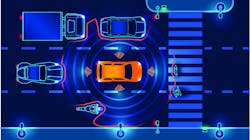Hybrid Computer Focuses on Image Recognition for Self-Driving Cars
Image recognition for autonomous cars and aerial drones rely on artificial intelligence and the ability to “teach” their onboard computers to recognize objects like a dog, a pedestrian crossing the street, or a stopped car. Unfortunately, computers running AI algorithms are too large and slow for future applications such as cars, drones, and handheld medical devices. Autonomous cars currently on the road almost all carry a relatively large, slow, and energy-intensive computer in the trunk.
To sidestep this limitation, researchers at Stanford University devised a new type of AI camera and computer that classifies images faster and more energy efficiently, and it should be possible to scale it down small enough to be carried in cars and smaller devices. The system is based on a hybrid optical-electrical computer designed specifically for image analysis.
The first layer of the system is an optical computer which does not require the power-intensive mathematics of digital computing. The second layer is a traditional digital computer. The optical computer preprocesses image data, physically filtering it in several ways an electronic computer would otherwise have to do mathematically. Because the filtering happens naturally as light passes through a set of custom optics, this layer needs no power.
The team effectively outsourced some of AI math to the optics. This saves a lot of time and energy that would otherwise be consumed by computation. It also means profoundly fewer calculations, fewer calls to memory, and far less time to complete the process. Millions of calculations are circumvented and it all happens at the speed of light. Having leapfrogged these preprocessing steps, the remaining analysis takes place in the digital computer layer.
The prototype rivals existing electronic-only computers programmed to perform the same calculations in speed and accuracy, but with substantial computational cost savings. And although the prototype, laid out on a lab bench, would hardly be called small, researchers said their system could be miniaturized to fit in a handheld video camera or an aerial drone.
In both simulations and real-world experiments, the system successfully identified airplanes, automobiles, cats, dogs, and more within natural image settings. The team believes a future version of the system would be especially useful in rapid decision-making applications, such as autonomous vehicles. The team is now working to make the optical component do even more of the preprocessing.

